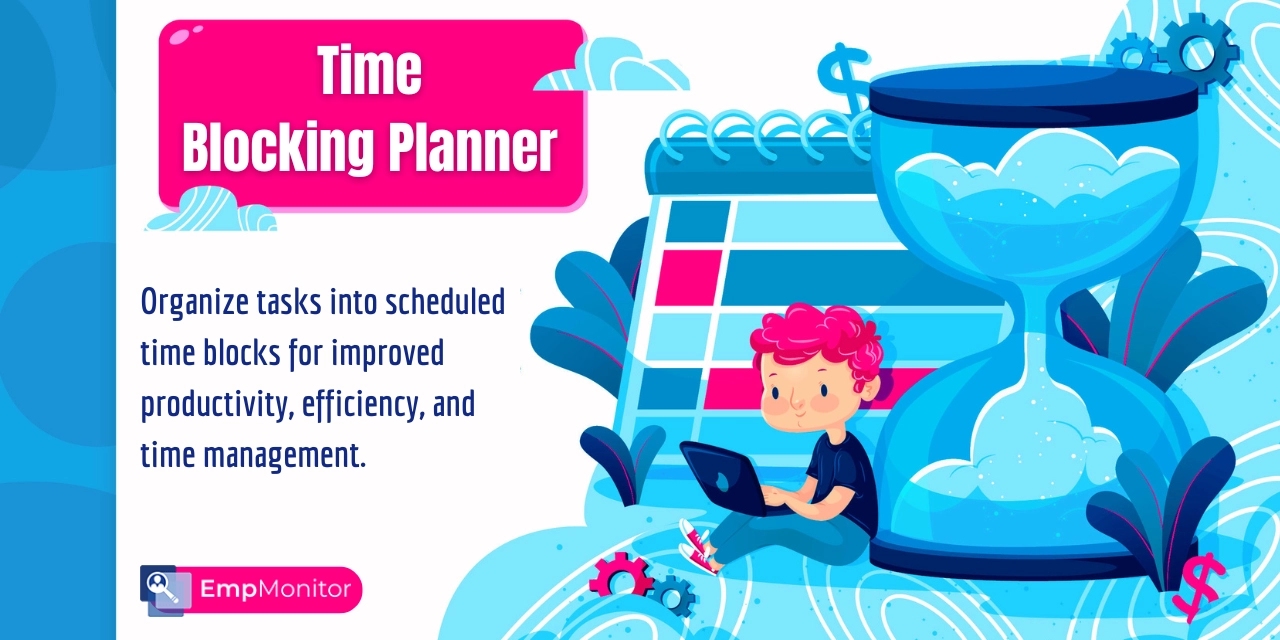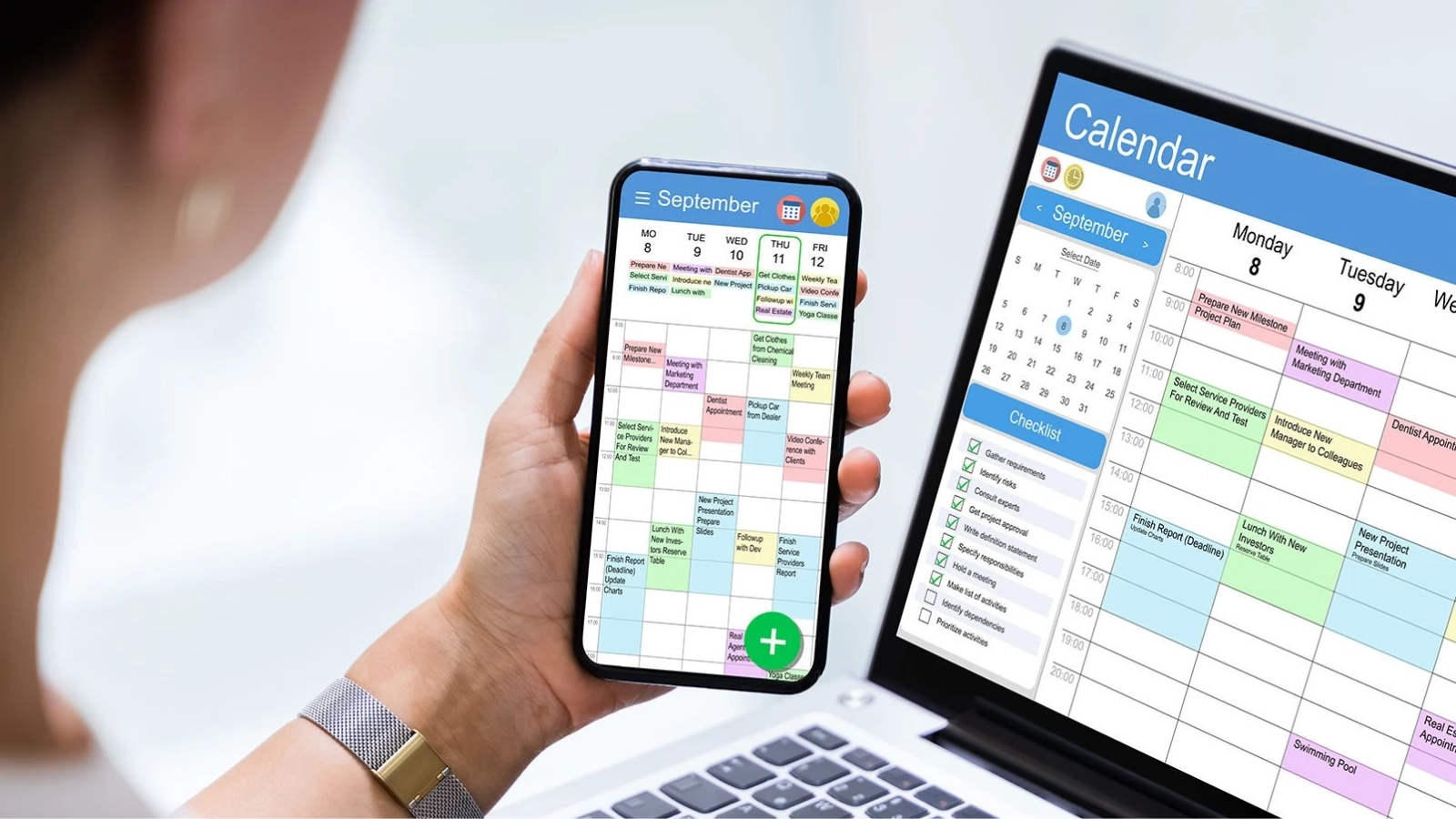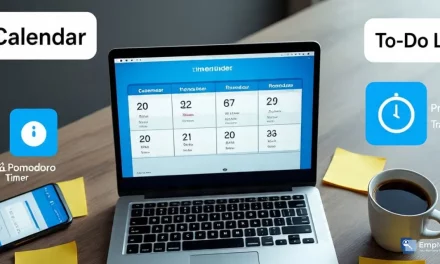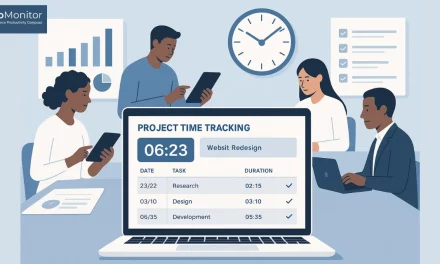Have you ever felt like there aren’t enough hours in the day to get everything done?
Time seems to slip away, leaving tasks unfinished and priorities in disarray. If you’ve experienced this frustration, you’re not alone.
Enter the world of time blocking. In this blog, we’ll explore time blocking planners and how they can transform your productivity and efficiency. Plus, we’ll provide you with three free time block templates to help you start your journey to better time management.
Ready to take charge of your work schedule?
Let’s dive in!
Listen To The Podcast Now!
What is Time Blocking?
Time blocking is a time management technique that involves dividing your day into blocks of time dedicated to specific tasks or activities. Instead of an open-ended to-do list, the best planner for time blocking helps structure your day by allocating fixed time slots for different responsibilities.
This method can be particularly effective in overcoming remote employee time tracking challenges by ensuring that every task, meeting, and break is accounted for, enhancing focus and productivity. It provides a clear overview of daily expectations, making it easier to balance both professional and personal commitments effectively.
By doing so, you create a roadmap for your day, ensuring that essential tasks are prioritized and completed efficiently.
Why Should Employers Use Time Blocking Planners?
Employers often face the challenge of maximizing productivity among their teams while also making sure that the work gets done on time. Introducing a time blocking planner within the workplace can offer several benefits:
Enhanced Productivity: Time blocking encourages employees to focus on one task at a time, minimizing distractions and increasing productivity levels.
Better Time Management: With a clear schedule in place, employees can allocate time for essential tasks, meetings, and projects, preventing last-minute rushes or missed deadlines.
Improved Work-Life Balance: By structuring work hours effectively, employees can achieve a better balance between professional and personal commitments, reducing stress and burnout.
Transparent Communication: Time blocking encourages open communication within teams regarding task priorities and availability, fostering a collaborative work environment.
The benefits of time blocking planners for employers are evident, but managing employees manually can often pose challenges. Keeping track of everyone’s schedules, ensuring tasks are assigned appropriately, and maintaining open communication can be a daunting task, especially in fast-paced work environments.
This is where employee management tools become essential. They simplify scheduling, task allocation, and team communication, helping employers manage their workforce more efficiently. Leveraging strategies like time mapping can further enhance these tools, ensuring smoother operations and better productivity. EmpMonitor is designed to meet the dynamic needs of today’s workplaces.
EmpMonitor| Employee Management Software
EmpMonitor is more than just a traditional employee management tool; it has features that could help the management simplify the complexities of workforce supervision and optimization.
Along with all the robust workforce management features it has an intuitive dashboard as well, which empowers employers to effortlessly manage schedules, allocate tasks, and foster collaboration across teams, regardless of their physical location.
Let’s check out the employee management features of this tool:-
Time Tracking Made Simple: EmpMonitor has a time tracking feature that allows employers to monitor employee hours effortlessly, track time spent on specific tasks or projects, and gain valuable insights into productivity trends. Whether employees are working remotely or on-site, this time-tracking software provides accurate and transparent time tracking capabilities to ensure accountability and optimize resource allocation.
Robust Data Security Measures: Protecting sensitive employee data is paramount in today’s digital landscape. EmpMonitor prioritizes data security by implementing robust encryption protocols, secure servers, and multi-factor authentication mechanisms. With EmpMonitor, employers can rest assured that their sensitive information is safeguarded against unauthorized access and cyber threats.
Screenshot Monitoring: EmpMonitor’s screenshot monitoring feature provides employers with a visual snapshot of employee activity, allowing them to monitor work progress and ensure compliance with company policies. By capturing screenshots at regular intervals, EmpMonitor offers a transparent view of employee productivity while respecting individual privacy and maintaining trust within the organization.
Productivity Tracking: EmpMonitor’s productivity tracking capabilities empower employers to measure and analyze employee performance effectively. By tracking key productivity metrics and generating detailed reports, employers can identify patterns, identify areas for improvement, and optimize workflows to enhance overall efficiency. With EmpMonitor, employers can make data-driven decisions that drive productivity and drive business growth.
Comprehensive Analytics Dashboard: EmpMonitor’s analytics dashboard offers a wealth of actionable insights, including productivity trends, time patterns, and employee engagement metrics. By visualizing complex data in an intuitive interface, EmpMonitor enables employers to identify opportunities for optimization, address performance bottlenecks, and foster a culture of continuous improvement.
By embracing technology and harnessing the power of EmpMonitor, employers can streamline operations, drive productivity, and propel their organizations towards success in today’s competitive landscape.
How Does Time Blocking Work?
Time blocking operates on the principle of allocating dedicated time slots for specific activities or tasks throughout the day. Here’s how you can implement time blocking effectively:
Identify Priorities: Begin by listing down the tasks and activities you need to accomplish within a given day or week. Prioritize them based on urgency and importance.
Allocate Time Blocks: Assign specific time slots to each task or activity, ensuring that you allow sufficient time for completion while avoiding overcommitment.
Maintain Flexibility: While time blocking provides structure to your day, it’s essential to remain flexible and adapt to unforeseen circumstances or emergencies.
Review and Adjust: Periodically review your time blocking schedule to assess its effectiveness. Make adjustments as needed to optimize your workflow and productivity levels.
Here’s to Planning Your Day in a Time Blocking Planner:
Creating a planner that aligns with your unique schedule and workflow requires careful consideration and planning. Here are some steps to help you get started:
Choose the Right Planner: Select the best time blocking planner that suits your preferences and needs. Whether it’s a digital app or a traditional paper planner, opt for a format that resonates with your organizational style.
Set Clear Goals: Define your overarching goals and objectives for each day or week. Divide them into smaller, bite-sized chunks that you can schedule within your blocks.
Establish Routines: Incorporate regular breaks, meal times, and moments of relaxation into your time blocking schedule. Balancing work with periods of rest is crucial for maintaining productivity and well-being.
Be Realistic: Avoid overloading your schedule with an excessive number of tasks or commitments. Allow buffer time between appointments and tasks to account for unexpected delays or interruptions.
Read More:
Time Mapping 101: Unlock Your Productivity Potential
How To Overcome Remote Employee Time Tracking Challenges?
How Does Time Batching Improve Workforce Productivity?
How To Master Time Blocking For Daily Productivity?
How to Make a Time Blocking Planner Work for You?
Making a time blocking planner work effectively for you involves a combination of strategic planning, disciplined execution, and continual refinement.
Here are some key steps to help you maximize the benefits of your blocking planner:
Set Clear Priorities: Before diving into time blocking, take the time to clarify your short-term and long-term goals. Identify the most important tasks and projects that align with your objectives. By understanding your priorities, you can allocate time blocks accordingly and ensure that essential activities receive the attention they deserve.
Understand Your Peak Productivity Hours: Pay attention to your natural energy levels and productivity patterns throughout the day. Identify your peak hours when you feel most alert and focused. Reserve these time blocks for tasks that require high levels of concentration or creativity. Conversely, allocate less demanding activities to periods when your energy naturally dips.
Break Tasks Into Manageable Chunks: Large projects or daunting tasks can feel overwhelming if tackled all at once. Divide them into smaller, easier-to-achieve chunks that you can execute in a single time frame. Set clear objectives for each task and establish milestones to track your progress over time.
Allocate Buffer Time: Allow for buffer time between consecutive time blocks to account for unexpected delays, transitions, or interruptions. Buffer periods serve as breathing room and help prevent schedule overruns. Use this time to catch up on unfinished tasks, review your progress, or recharge before diving into the next activity.
Minimize Distractions: Create an environment conducive to focus by minimizing distractions and interruptions. Silence notifications, set boundaries with colleagues or family members, and designate a dedicated workspace free from clutter and noise. Implementing strategies such as the Pomodoro Technique, which involves alternating focused work sessions with short breaks, can also enhance productivity.
Stay Flexible and Adapt: While time blocking provides structure to your day, it’s important to remain flexible and adaptable to changing circumstances. Unexpected events, urgent requests, or unforeseen challenges may require adjustments to your schedule. Embrace agility and be prepared to rearrange time blocks as needed while staying mindful of your overarching goals.
Review and Reflect Regularly: At the end of each day or week, take time to reflect on your time blocking experience. Take a look at how your schedule is performing, and what you need to work on, and celebrate what you’ve accomplished. Are there tasks that consistently take longer than expected? Are there recurring distractions that disrupt your focus? Use these insights to refine your time blocking strategy and optimize your productivity over time.
Celebrate Progress and Practice Self-Compassion: Recognize that productivity is not about perfection but about progress. Celebrate small victories and milestones along the way. Be kind to yourself on days when things don’t go as planned.
Remember that setbacks are opportunities for growth and learning. By cultivating a positive mindset and fostering self-compassion, you can navigate the ups and downs of time blocking with resilience and grace.
Incorporating these strategies into your time blocking planner routine can help you harness the full potential of this powerful productivity tool and achieve greater balance, focus, and fulfilment in your daily life.
3 Free Time Block Templates
To assist you in implementing time blocking effectively, we’ve curated three free time block templates designed to suit various scheduling preferences and lifestyles:
Time Blocking Daily Planner Template: This template allows you to plan your day hour by hour, allocating specific time slots for tasks, appointments, and personal activities.
Weekly Time Blocking Planner Template: Ideal for individuals with dynamic schedules, this template offers a comprehensive overview of your entire week, enabling you to allocate time blocks across different days and adjust as needed.
Monthly Time Blocking Template: With a focus on long-term planning and organization, this template provides a structured overview of your entire month. By allocating time blocks for recurring commitments, deadlines, and personal goals, you can maintain clarity and focus throughout the month while ensuring that important tasks are prioritized and accomplished.
Conclusion
Mastering the art of time blocking with a dedicated time blocking planner can revolutionize your approach to productivity and time management. By intentionally allocating time, setting clear priorities, and maintaining focus, you can achieve greater efficiency and fulfillment in both your professional and personal endeavors. Integrating time batching—grouping similar tasks together—further boosts productivity by reducing the mental energy required to switch between different types of activities.
Remember, the key to success lies not just in planning your time but in executing your plans with discipline and purpose. Embrace the combined power of time blocking and time batching, and watch as these strategies transform your life one block at a time.
FAQs –
1. How does a time-blocking planner improve productivity?
Ans: By allocating specific time blocks for each task, a time-blocking planner minimizes distractions and helps you stay focused on one task at a time. It also aids in prioritizing tasks and managing your time more effectively.
2. What are the benefits of using the best time-blocking planner?
Ans: The best time-blocking planners offer features like customizable time blocks, space for goal setting, and tracking progress. They help streamline your schedule, reduce procrastination, and provide a clearer overview of your daily tasks.
3. Can I use a time-blocking planner for personal and professional tasks?
Ans: Yes, a time-blocking planner is versatile and can be used for both personal and professional tasks. It helps you balance work responsibilities, personal commitments, and leisure activities within a structured schedule.
4. What makes a time-blocking daily planner effective?
Ans: An effective time-blocking daily planner should be easy to use, offer flexibility in time block sizes, and provide space for notes or adjustments. Features like goal tracking and visual organization also enhance its effectiveness.
5. How can time-tracking software complement a time-blocking planner?
Ans: Time-tracking software can be used alongside a time-blocking planner to monitor how effectively you adhere to your scheduled time blocks. It provides data on how your time is spent, helping you adjust your planner and improve time management.
6. Where can I find free time block templates?
Ans: You can download free time block templates directly from our blog. We provide customizable PDF templates for daily, weekly, and monthly planning to help you get started with time blocking right away.
















